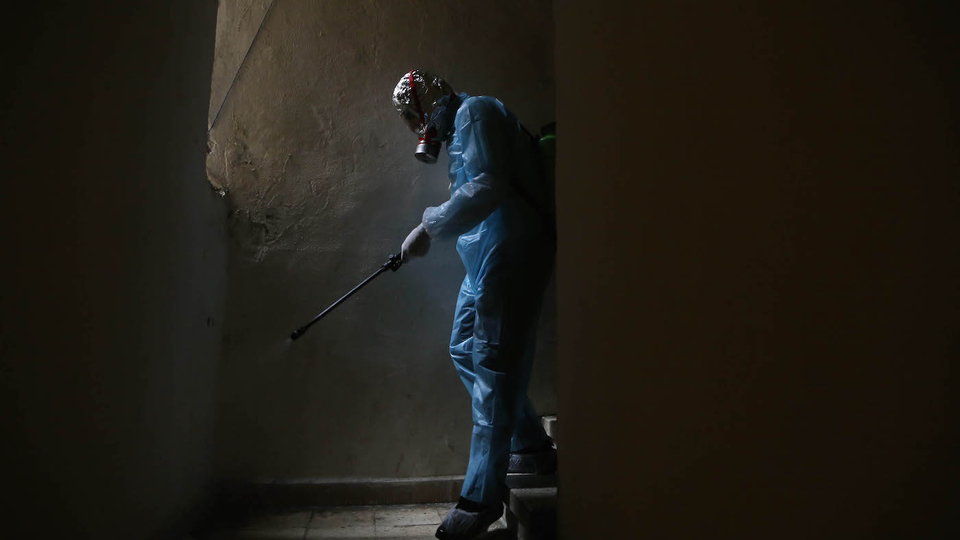Too Little Too Late: A Timeline of Lebanon’s Response to COVID-19
In early August 2020, residents of Lebanon witnessed a rare public dispute between Health Minister Hamad Hassan and Interior Minister Mohammed Fahmi. The health minister said on local television station LBCI weddings under certain conditions could be held during a COVID-19 lockdown with an “exceptional approval” from his ministry. The interior minister, on the other hand, contradicted his colleague in a statement and issued a fine to one of the recipients of this exceptional approval, which he said constitutes an “overriding of his authority.” Health Minister Hassan then clarified in an interview with Al Jadeed television that he was referring to health and safety recommendations made by the Health Ministry during a two-day lull period between lockdowns, and that there were no official exemptions for weddings in the first place. Confusing? This is arguably Lebanon’s COVID-19 response in a nutshell, especially after a series of lockdown-like measures enforced since March 15 under a so-called "state of general mobilization”.
This was certainly not the first instance that the Lebanese government's response to COVID-19 would spark widespread confusion in the country. Conflicting responsibilities and jurisdictions, unilateral decisions and a lack of clear communication, palpably absent preventive actions, and delayed responses have characterized the government’s response to the pandemic since the first case was recorded in February.
Conflicting responsibilities and jurisdictions, unilateral decisions and a lack of clear communication, palpably absent preventive actions, and delayed responses have characterized the government’s response to the pandemic since the first case was recorded in February.
Cabinet and its ministers had previously boasted about the praise they received from the World Health Organization (WHO), some European countries and the international press for their ability to contain the COVID-19 outbreak in the middle of a devastating economic crisis. This praise was echoed internally by officials and politicians. The reality on the ground, however, reveals an entirely different picture.
The Lebanese government started gradually lifting restrictions in early May, topped off with the reopening of the airport on July 1. The only explanation for this decision was the government’s desire to boost the economy by allowing expats to bring much needed US dollars into the country as the number of tested cases was 1,719. But these relaxed measures led to a rise in the number of infections, and by July 27, 3,879 coronavirus cases had been confirmed.
The government responded to this rise by reinstating a country-wide partial lockdown from July 30 to August 3, and again from August 6 to August 10 after a 48-hour lull period. This decision was widely criticized as there was no warning or explanation behind the selection of non-consecutive days, which coincided with Islamic holiday Eid al-Adha during the first few days.
Cases started to surge following the Beirut Port explosion on August 4, with hospitals short on supplies and operating on minimal capacity, with several key hospitals in the capital heavily damaged by the explosion. Intensive care units reached an alarming 82 percent capacity in October. By mid-november, daily cases had routinely exceeded the 1000-mark. The Lebanese government on November 10 announced a lockdown and curfew from November 14 until the end of the month, with some exemptions including workers in the health sector.
As of November 9, the surge of cases included at least 1,502 medical workers. According to a source from the Syndicate of Physicians, 17 of the 300 doctors at Saint George Hospital (SGH) were infected with the virus and were admitted to the hospital’s Intensive Care Unit. One of the largest in Beirut, it was forced to close its emergency room doors to new cases because it reached capacity.
This report documents the timeline of government decisions and measures, most of which were reactive instead of preemptive or preventive. This highlights the government’s failure to adhere to and implement an already existing legal framework which facilitates preventive actions.
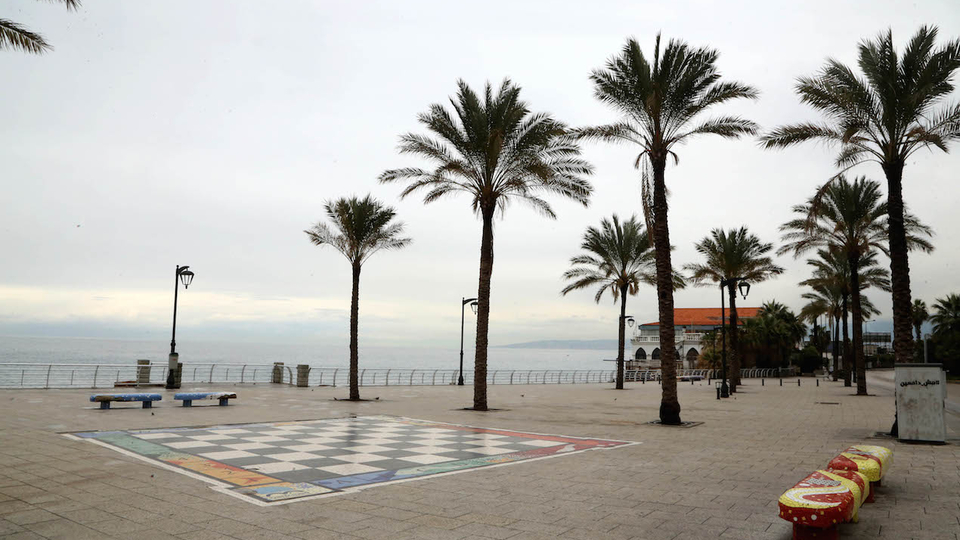
The usually bustling corniche is deserted under lockdown. Beirut, Lebanon. March 20, 2020. (Hussein Baydoun/The Public Source)
Where It All Began
On February 21, 2020, the country’s first COVID-19 case was recorded when a Lebanese woman returning from Iran tested positive. Prior to this, on February 4, the government committee tasked with combating the virus met for the first time to discuss preventive measures and procedures. A WHO representative was present, yet no action followed the meeting.
The representatives of the institutions and delegates of the committee were tasked with developing a contingency plan for facing this crisis. According to a statement released by the committee, it proposed a response mechanism and emergency monitoring in addition to a recommended work plan, but no details were made public.
Immediately after the first case was announced, the Lebanese government demonstrated its lack of preparedness by failing to take swift and effective action to prevent the spread of the virus. In retrospect, it is clear that the government primarily treated the pandemic as a security threat rather than a health crisis with lasting societal repercussions, with its committee headed by a military official — rather than a medical expert.
The first action taken by the government upon the detection of the first case to Lebanon was to halt the export of medical personal protective equipment and other tools that prevent contagious diseases. But this decision was not taken preemptively, as was the case in other countries, and was only implemented after at least 4 million medical masks (both N95 and surgical) had already been exported, according to obtained exchanges between merchants. These masks were sold over 30 times their original purchase price, according to the Medical Equipment and Devices Importers Syndicate.
A pharmacist speaking on the condition of anonymity in the southern city of Nabatieh said pharmacies used to buy a pack of 50 masks for $2.5-$3.5, while five masks were sold for 1,000 LBP (less than a dollar at the official exchange rate of 1,500 LBP). But once the first case was announced, masks disappeared from pharmacies, only to reappear a few days later with a significant markup. Merchants sold a pack of 50 to pharmacies for an amount ranging between 35,000 LBP (approximately $23) at the early stages of the crisis and 55,000 LBP (approximately $36) two months later. At that time, the consumer price for one mask ranged between 2,000-5,000 Lira ($1.5-$3). According to the same source and other pharmacists, merchants manipulated the mask market by holding back stocks and selling masks that were imported before October 17, 2019 without government regulation or accountability. Despite the price increase, Internal Security Forces checkpoints were strict and imposed fines on those not wearing masks.
[P]harmacies used to buy a pack of 50 masks for $2.5-$3.5 ... But once the first case was announced, masks disappeared from pharmacies, only to reappear a few days later with a significant markup. Merchants sold a pack of 50 to pharmacies for an amount ranging between 35,000 LBP (approximately $23) at the early stages of the crisis and 55,000 LBP (approximately $36) two months later.
On March 17, the government decided to try to reduce the prices of sanitizers and disinfectants. Adding to the dramatic increase in market prices, tests and studies conducted by the state-run Industrial Research Institute revealed that three out of 10 hand sanitizer brands on the market do not meet the required specifications.
On March 19, after the number of cases reached 149, efforts were made to identify and source the equipment needs of local public hospitals for one month, also aiming to supply medical personnel with personal protection equipment. This included gathering information on potential isolation centers across the country. At that point the health ministry had identified and mapped public sector options across the country, with top-level private hospitals considered merely a backup with no information about their capacity.
On March 22, Interior Minister Fahmi announced that strict measures for security agencies and local government administrations were set up. It seems, however, that these measures were implemented far too late. Lebanon’s National Coronavirus Response Plan announced on March 10 that these measures should have been taken after the first few positive cases were identified as they were still geographically limited. The first case was confirmed a month prior to Fahmi’s measures.
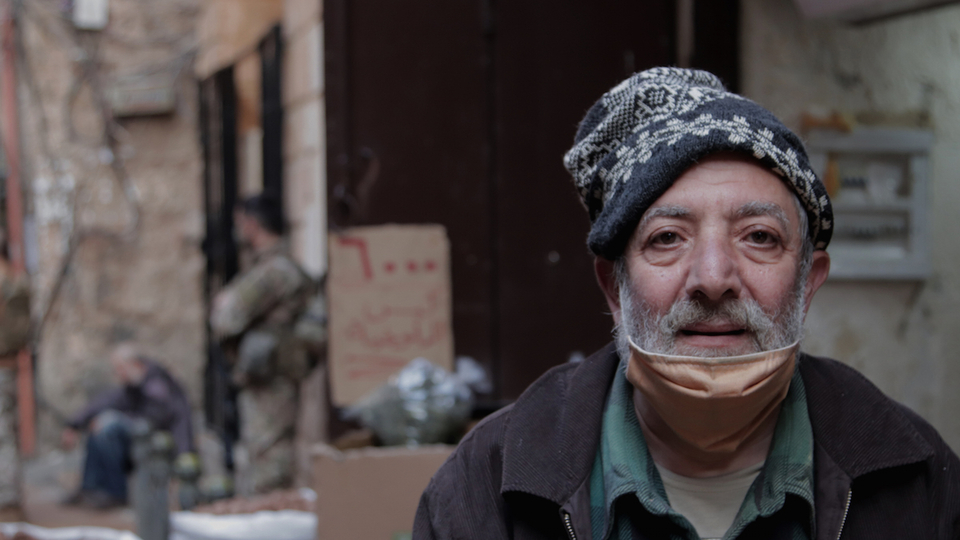
An elderly perfumer gets ready to close his shop in al-Rifa'iyah market ahead of curfew. Tripoli, Lebanon. November 22, 2020. (Fátima Fouad/The Public Source)
Waiting for the Outbreak
Lebanon’s national response plan called for significant measures after the third stage, which is when there are a handful of isolated cases. The plan was approved several weeks after Lebanon confirmed its first case, and is most elaborate on its measures in the event of a “full outbreak,” known as the fourth stage.
Meanwhile, a discrepancy appeared in the number of cases recorded by the Health Ministry and the Disaster Management Unit overseen by the prime minister's office. The former recorded 52 cases while the latter reported 58. This discrepancy continued until March 13, as Lebanon reached the third stage: the “virus containment” stage.
The most notable measures stipulated in the plan for this phase are as follows:
1- Monitoring land, sea, and air borders by checking the temperatures of travelers coming into the country, and asking them to provide information regarding their potential exposure to the virus.
2- A vague travel ban on “affected places.”
3- Conducting laboratory tests for suspected cases at the government-run Rafic Hariri University Hospital.
4- Adopting a track and trace approach by investigating those who have come into contact with positive cases. This procedure had no specific instructions for implementation until after the announcement of a lockdown on March 15. In those five days, the number of confirmed cases had jumped from 58 to 99, according to the Ministry of Health.
5- Receiving support from other institutions, including municipalities to monitor quarantining cases, security agencies to surveil travel and border crossings, and the Information Ministry to implement awareness campaigns.
6- Evaluating the capacity of public hospitals to treat COVID-19 patients, and prepare the necessary protective gear and medical equipment.
On March 30, the Ministry of Health issued a memo on how to handle infected or suspected infected corpses ... “The corpse must be wrapped in a sealed, insulated plastic bag, and all surfaces, equipment, and transport vehicles used must be cleaned, sterilized, and decontaminated. The body must be transported from the morgue directly to the graveyard.”
On March 30, the Ministry of Health issued a memo on how to handle infected or suspected infected corpses.
It states the importance of “avoiding exposure to the deceased's fluids and the proper use of protection during the preparation and shrouding of the body.” Additionally, “if the corpse requires washing, an insulating robe covering the entire body, goggles or a mask, and gloves must be worn.” Furthermore, “the corpse must be wrapped in a sealed, insulated plastic bag, and all surfaces, equipment, and transport vehicles used must be cleaned, sterilized, and decontaminated. The body must be transported from the morgue directly to the graveyard.” During the burial, “it is imperative to avoid touching the body of the deceased and the ceremony should be restricted to the immediate family. Condolences should be communicated over the phone or through online social media platforms.”
The aforementioned communication came 20 days after the first death on March 10 and when the number of coronavirus-related deaths had reached 11.
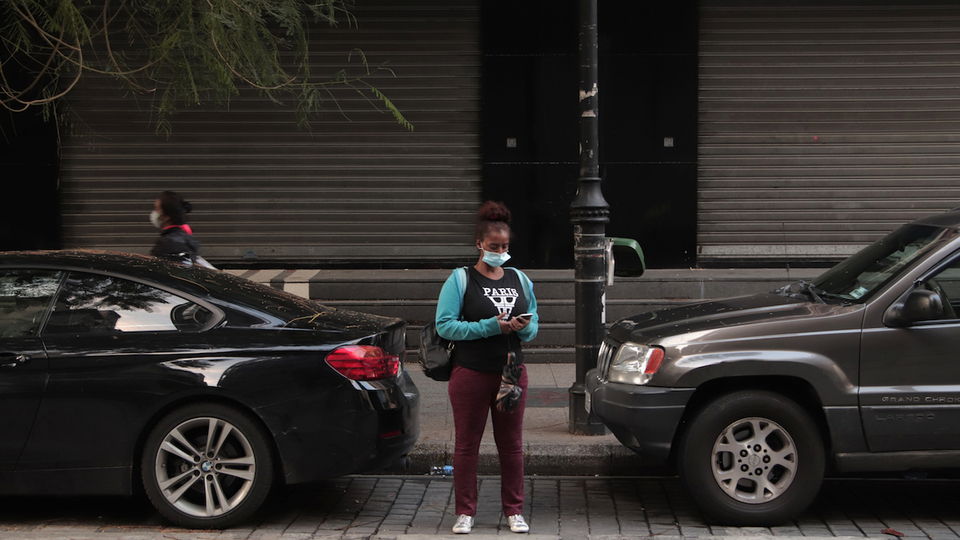
A woman waits for a taxi ahead of the 5 p.m. curfew along the shuttered Hamra Street in Beirut, Lebanon. November 27, 2020. (Fátima Fouad/The Public Source)
Airport Activity and Selective Flight Suspension
On February 25, the Lebanese government, like many governments around the world, began to control air traffic, especially from countries with higher rates of infection, and blocked religious travel and pilgrimage. Iran and Italy were exempt from this rule on the pretext of allowing Lebanese citizens to return to Lebanon. Both countries, however, had already reported what were then high infection rates (300 in Italy and 100 in Iran) and are religious destinations.
The measures taken to mitigate the risk of infection in arrivals at Rafic Hariri International Airport from Iran and Italy were limited to temperature checks and the completion of health forms. It was later revealed that the health forms were designed for Ebola cases, but flight crew were told that the form “also applies to the coronavirus.” At least eight testimonies reported that these forms were ignored on some flights.
The airport did not completely shut down until March 18, when Italy had recorded 28,710 cases, and Iran 10,516.
It was later revealed that the health forms were designed for Ebola cases, but flight crew were told that the form “also applies to the coronavirus.” At least eight testimonies reported that these forms were ignored on some flights.
Lebanese nationals abroad were given a grace period to return to Lebanon before the airport’s closure. But upon their arrival they were allowed to go home without isolating in quarantine centers or following any other special procedures. The government relied on self-isolation instead.
As expected, various returning nationals did not abide by the imposed self-isolation periods. In one case, the virus was transmitted to a soldier working inside a military court, which led to the infection of at least 13 of his colleagues. This incident clearly indicates that necessary preventive measures were not enforced in the workplace, according to a statement issued by the Lebanese army.
Expatriates made up the majority of cases recorded in Lebanon during that period. A report issued by the Health Ministry on March 11 shows that cases were divided as follows: 37 percent were expatriates (from Egypt, the UK, Iran, and Switzerland); 58 percent were in contact with confirmed cases (13 were in contact with a confirmed case from Egypt, five were in contact with a confirmed case from the UK, and five were in contact with a confirmed case from Iran). There were three other unspecified cases under investigation.
While the number of lab-confirmed cases on March 11 reached 61, this is not an accurate representation of the actual number of cases as tests were limited to those exhibiting symptoms or those originating from countries where the pandemic had already spread.
Furthermore, tests at the Rafic Hariri University Hospital’s lab were limited to approximately 74 per day. This strategy meant that it was up to asymptomatic individuals to self-diagnose and consequently self-isolate.
It was not until April 18, when the number of cases reached 672 and the number of deaths reached 21 that the Health Ministry began taking random samples from different regions to determine the actual spread of the virus and take the necessary measures. It is worth noting that the National Plan had indicated that private hospitals would not be used to treat cases until full capacity was reached in all government hospitals. This is in spite of the fact that private hospitals in Lebanon are more equipped with personnel and technical resources in comparison with government hospitals.
To justify the lack of testing, the Health Ministry invoked the country’s financial deficit. The Syndicate of Private Hospital Owners said in a statement that “clients” will not enter hospitals that are known to house coronavirus patients. On March 16, the Health Ministry paid approximately 20 billion LBP ($13 million at the official exchange rate, around $7.9 million at the black market rate) in private hospital dues. On April 22, Parliament issued additional provisions worth 450 billion LBP ($300 million at the official exchange rate and about $137.4 million at the black market rate) for these hospitals.
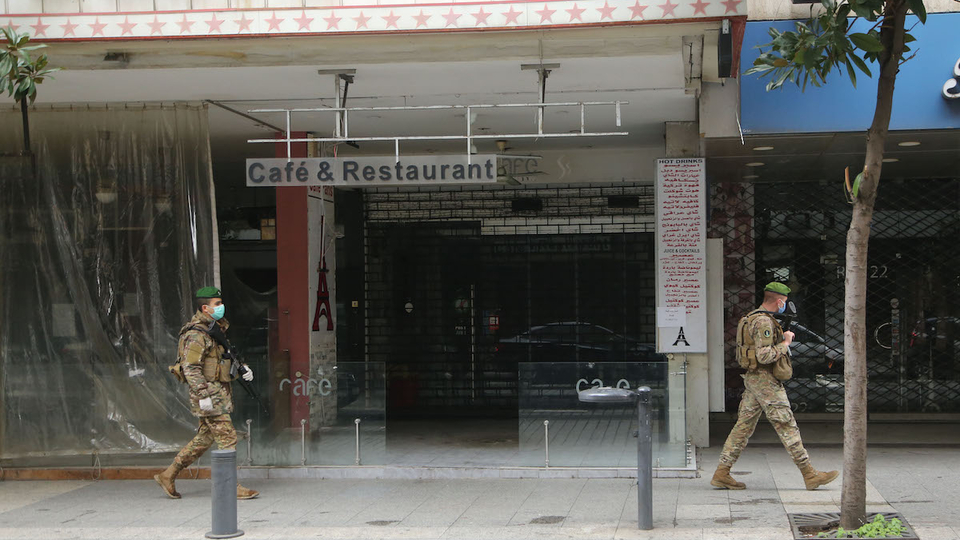
Lebanese army soldiers patrol Hamra Street during the state of general mobilization. Beirut, Lebanon. March 20, 2020. (Hussein Baydoun/The Public Source)
Nationwide Lockdown: Security Measures Instead of Preventive Measures
On March 15, the Health Ministry documented 99 cases before the government officially announced the implementation of a nationwide state of general mobilization that same day.
Following the general mobilization announcement, the government shut down all public and private institutions, with the exception of security institutions and administrations in charge of necessary operations (such as electricity, water, and social security), hospitals, medical institutions, pharmacies, supermarkets, food establishments, and factories that produce food and related primary material such as cardboard, and media institutions. Everyone was required to stay home unless necessary.
The Interior Ministry began to enforce the lockdown on March 21 and to strictly monitor violations as cases continued to increase. That same day, the Health Ministry announced 43 new cases, a sharp increase comparatively. Inconsistencies between the Health Ministry and the Disaster Management Unit, however, started becoming apparent, with the latter recording 67 new cases and a total of 230 cases.
On March 27, a curfew was imposed between 7 p.m. and 5 a.m., and on April 5, the Interior Ministry set a specific time for cars, trucks and motorcycles to travel according to their plate numbers. From then on, curfew hours varied according to the number of recorded cases.
Just a few days into the random testing phase, before the results revealed the extent to which the virus had spread, the Higher Defense Council on April 24 called on gradually reopening the country over the next two months in a five-stage plan. This action was taken in spite of the health minister’s reservations against the gradual resumption of “normal” activity. Shortly after, on May 13, the country was once again on full lockdown.
The government justified the decision to gradually reopen both on the relatively small number of new daily cases and on the fact that no new cases were reported on April 21. The government also assumed that it would be possible to transition out of the lockdown because the country was at a point where the number of cases was still proportional to hospital capacities and found no evidence of a potential outbreak.
As mentioned earlier, however, the number of cases reported by those returning to Lebanon continued to increase. Thirty-four new cases were recorded on May 7, only one of which was carried by a permanent resident while the rest were by expatriates. And the result was a general spike among those who were in contact with expats.
[T]he government primarily treated the pandemic as a security threat rather than a health crisis with lasting societal repercussions, with its committee headed by a military official — rather than a medical expert.Here, two key failures and weaknesses can be identified. First, the authorities were unable to enforce and monitor a two-week quarantine period for those returning to Lebanon. Second, they failed to use the 46 quarantine centers that were already established.
The government blamed the increase in the number of cases on the public. Interior Minister Mohammad Fahmi threatened to enforce stricter rules and increase the fine for general violations from 50,000 LBP ($33 at the official exchange rate) to 3 million LBP ($2,000 at the official exchange rate). He also threatened to completely shut down the country if residents continued to disregard self-imposed preventive measures.
These threats were not accompanied by any incentives to adhere to lockdown procedures, especially given that 40 percent of the population were at risk of living in poverty, as Prime Minister Hassan Diab announced on March 7.
To make matters worse, already compounded by a worsening economic crisis, most businesses cut their employees’ salaries. The majority of employees now earn half or a third of their salary, while day laborers have almost completely lost their income. Consequently, a large segment of the population can no longer secure or afford basic necessities such as food and housing as prices continue to skyrocket.
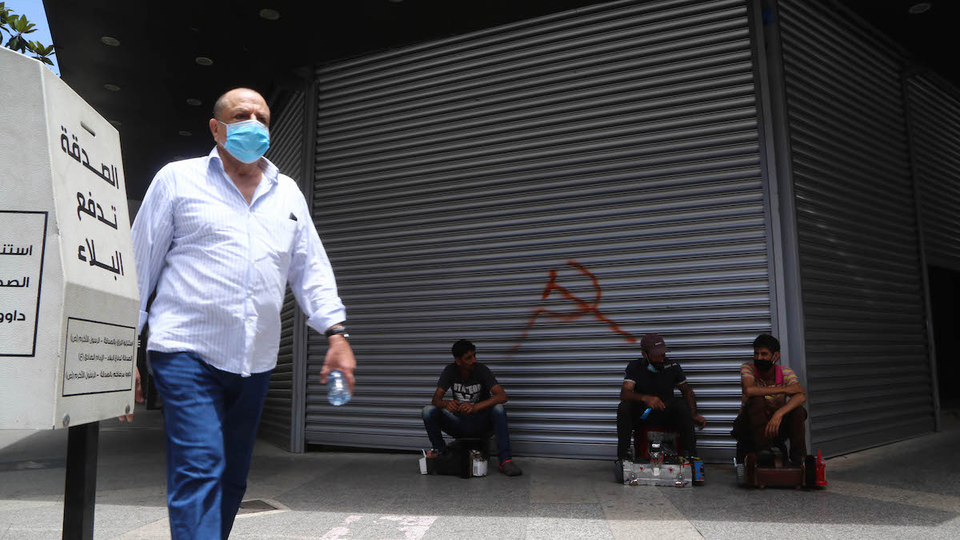
Shoeshiners rest on the street while waiting for customers. Hamra, Beirut. June 22, 2020. (Hussein Baydoun/The Public Source)
Unkept Promises of Financial Compensation
On March 17, the government decided to distribute assistance to citizens whose jobs were disrupted and had lost their income. This meant that the government would provide food rations to the families that needed it the most. This emergency plan was not approved until March 26, however, and would not be implemented before April 15.
On March 31, a few days after the plan was approved, the government changed course and decided to provide a cash assistance of 400,000 LBP ($266 at the official rate and around $143 at the black market rate) instead of distributing food to the families most in need. They also announced that the Lebanese Army would distribute these cash transfers, but did not give a timeline on when that would be implemented.
On April 10, the Social Affairs Ministry announced that the distribution of this aid would begin four days later on April 14, but distribution was postponed that same day when the army’s review revealed that the list of beneficiaries included families that did not need assistance.
After the beneficiaries were reviewed, the government decided to provide cash assistance to families included in the ministry's “Poorest Families Support Program.”
Eventually, on April 22, the cash transfers were distributed by military personnel over several phases. This aid only materialized two months after people lost their income, sparking a series of protests, road closures, and clashes with security forces and military personnel over their deteriorating living conditions.
The country continued to reopen through the gradual reopening plan on May 18, following a four-day lockdown as a result of a spike in COVID-19 cases. But despite this, no new meaningful measures were put in place to prevent a second wave, and was no different from previous attempts to resume normal activity.
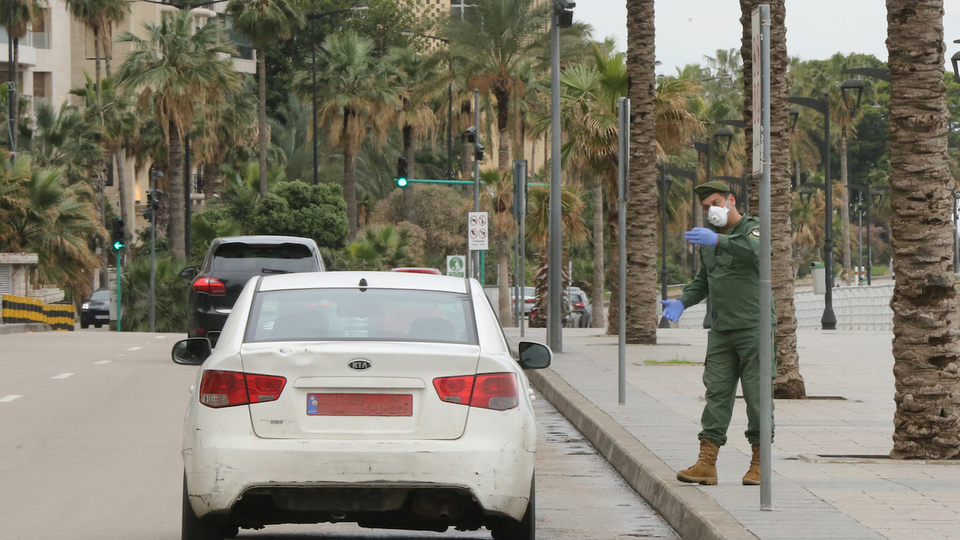
A Beirut municipal police officer controls the flow of traffic by the corniche. Beirut, Lebanon. March 20, 2020. (Hussein Baydoun/The Public Source)
"Safe Distance" Determined by Police
The ways in which ministries responded to the end of a lockdown varied. Some were able to apply minimal preventive measures, although this was also implemented much later than intended while others completely avoided taking any precautions. The finance and health ministries, for example, did not specify any preventive measures, like maximum capacity in commercial establishments to ensure safe distancing. Instead, haphazard measures were at the discretion of security forces, lacking any clearly communicated criteria.
The Health Ministry ... did not use its power to actively respond to the crisis. The Infectious Diseases Law, passed in 1957, gives the ministry the power to issue decrees specifying the measures that would prevent the spread of epidemics in the country. The decree also outlines the delegation of authorities for each department and the measures they are required to take, as well as their composition, specialties, and the duration of their authority to implement required measures.
Furthermore, Lebanese authorities did not use the already existing frameworks to tackle the crisis. Instead, they attempted to confront the crisis without any compulsory legal follow-up or administrative measures that could apply to citizens and public administrations.
The Health Ministry, for instance, did not use its power to actively respond to the crisis. The Infectious Diseases Law, passed in 1957, gives the ministry the power to issue decrees specifying the measures that would prevent the spread of epidemics in the country. The decree also outlines the delegation of authorities for each department and the measures they are required to take, as well as their composition, specialties, and the duration of their authority to implement required measures. It also stipulates that all expenses required for the implementation of these measures are to be covered by the government, and that major municipalities shall bear a quarter of these expenditures, according to Article 9 of this law.
Article 10 allows the Health Ministry to establish a “health zone” on any affected place, and prohibit, restrict or control entry to and exit from the area.
At a time when the daily number of cases routinely exceeds the 1,000-mark, we find that the government is unable to contain the outbreak of COVID-19. Additionally, the government is no longer capable of enforcing a full lockdown due to the deteriorating condition of the country’s economy.
At the time of writing, Lebanon had registered nearly 123,000 total cases, with over 48,000 of them active, as 947 individuals have died of COVID-19. If the current situation continues, the number of cases may exceed the capacities of both government and private hospitals to accommodate new patients and this health crisis will continue to threaten the lives of the residents of Lebanon in the short and long term, unless science-based recommendations are implemented and social safety nets are provided to the growing number of vulnerable families.
This report is part of a series of investigations into the COVID-19 pandemic in the Arab world. It was conducted with the support of the Arab Reporters for Investigative Journalism (ARIJ).
Additional reporting, fact-checking, and translation by Kareem Chehayeb, Christina Cavalcanti, Lama Abu Kharroub, and Omar Thawabeh.
